The Dos and Don’ts of Boat Docking
Docking your beloved vessel can amplify the joy of owning a boat, but it can also spike your adrenaline. The serenity of the open water gives way to the precision and technique of approaching the dock just right. To help you seamlessly transition from waves to wharf, here are the essential dos and don’ts of boat docking.
The Dos
When it comes to docking, there are certain crucial practices that all skippers should follow for dock safety. Here are some of those.
Be Prepared
Before you even lay eyes on the dock, ensure that fenders are in place and lines are prepped. Think ahead about the speed and angle at which you’ll approach and have an assistant ready to handle lines.
Preparation can turn a potentially nerve-wracking situation into a smooth and controlled maneuver. Ask an expert to know where is the best docking area and how to find boat slips near me.
Move Slowly and Steady
The most effective technique for boat docking is to approach at the slowest speed that still allows for steerage, typically what’s known as “idling speed.” This not only gives you better control but minimizes the risk of damage to your boat or the dock in case of miscalculation.
Aim to Drift
Rather than attempting to “park” your boat at the dock, use the boat’s natural momentum to glide alongside. Keep the engine in neutral or in reverse occasionally to adjust, but try to avoid keeping it in gear and idling too close to the dock, as this can lead to overheating or mechanical issues.
Communicate
Good communication is key, whether that’s with a fellow passenger, a marina attendant, or anyone helping you dock. Establish signals you’ll use and ensure they’re understood before you begin your approach. Clear communication can prevent missteps and potential accidents.
The Don’ts
Avoiding these common mistakes can make all the difference in a safe and successful docking. Here are some don’ts in boat handling.
Don’t Panic
It’s easy to feel overwhelmed when docking, especially if conditions are less than ideal. But panicking will only make the situation worse. Stay calm, think through each step, and remember that practice makes perfect.
Don’t Be Afraid to Abort
If at any point during your approach, you feel things aren’t going as planned, it’s okay to abort and reassess. Circle back around and give yourself a second attempt. Ego should never take precedence over safety.
Don’t Yell Commands
Yes, the engine can roar, and the harbor can be a noisy place, but yelling commands only adds to the chaos. Instead, use clear, calm, and firm communication, even if it means resorting to hand signals and pre-discussed maneuvers.
Don’t Forget to Account for the Current
Currents can significantly affect your boat’s movement, sometimes in counterintuitive ways. Always approach a dock with the current in mind, compensating for it in your speed and angle of approach.
Be Mindful in Boat Docking
By adhering to these guidelines, you can transform boat docking from a challenge to a satisfyingly smooth operation. Remember, every successful docking is a victory that hones your seamanship skills and deepens your love for life on the water.
These tips are invaluable for ensuring everyone comes back safe, sound, and ready for the next voyage. This is whether you’re an experienced mariner or you’ve just embarked on your nautical adventures.
If you want to read more articles, visit our blog.

